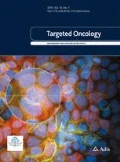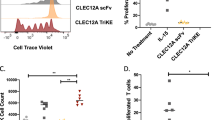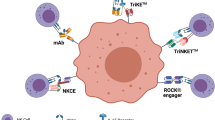Abstract
Background
Natural killer (NK) cells are potent cytotoxic lymphocytes that play a critical role in tumor immunosurveillance and control. Cancer stem cells (CSC) initiate and sustain tumor cell growth, mediate drug refractory cancer relapse, and express the well-known surface marker CD133.
Methods
DNA fragments from two fully humanized single chain fragment variable (scFv) antibodies recognizing CD16 on NK-cells and CD133 on CSC were genetically spliced forming a novel drug, 16 × 133 BiKE that simultaneously recognizes these antigens to facilitate an immunologic synapse. The anti-CD133 was created using a fusion protein prepared by fusing DNA fragments encoding the two extracellular domains of CD133. Immunization of mice with the resulting fusion protein generated a unique antibody that recognized the molecular framework and was species cross-reactive.
Results
In vitro chromium-51 (51Cr) release cytotoxicity assays at both high and low effector:target ratios demonstrated the ability of the heterodimeric biological drug to greatly enhance NK-cell killing of human Caco-2 colorectal carcinoma cells known to overexpress CD133. The tumor associated antigen specificity of the drug for CD133 even enhanced NK-cell cytotoxicity against the NK-resistant human Burkitt's lymphoma Daudi cell line, which has less than 5 % CD133 surface expression. Flow cytometry analysis revealed increases in NK-cell degranulation and Interferon-γ production upon co-culture with Caco-2 targets in the presence of the drug.
Conclusion
These studies demonstrate that the innate immune system can be effectively recruited to kill CSC using bispecific antibodies targeting CD133 and that this anti-CD133 scFv may be useful in this bispecific platform or perhaps in the design of more complex trispecific molecules for carcinoma therapy.








Similar content being viewed by others
References
Harper LJ, Piper K, Common J, Fortune F, Mackenzie IC. Stem cell patterns in cell lines derived from head and neck squamous cell carcinoma. J Oral Pathol Med. 2007;36(10):594–603.
Wright MH, Calcagno AM, Salcido CD, Carlson MD, Ambudkar SV, Varticovski L. Brca1 breast tumors contain distinct CD44+/CD24- and CD133+ cells with cancer stem cell characteristics. Breast Cancer Res. 2008;10(1):R10.
Du Z, Qin R, Wei C, Wang M, Shi C, Tian R et al. Pancreatic cancer cells resistant to chemoradiotherapy rich in "stem-cell-like" tumor cells. Breast Cancer Res. 2011;56(3):741–50.
Fabrizi E, di Martino S, Pelacchi F, Ricci-Vitiani L. Therapeutic implications of colon cancer stem cells. World J Gastroenterol. 2010. 16(31):3871–7
Corbeil D, Roper K, Weigmann A, Huttner WB. AC133 hematopoietic stem cell antigen: human homologue of mouse kidney prominin or distinct member of a novel protein family? Blood. 1998;91(7):2625–6
Corbeil D, Roper K, Hellwig A, Tavian M, Miraglia S, Watt SM et al. The human AC133 hematopoietic stem cell antigen is also expressed in epithelial cells and targeted to plasma membrane protrusions. J Biol Chem. 2000;275(8):5512–20
Yin AH, Miraglia S, Zanjani ED, Almeida-Porada G, Ogawa M, Leary AG et al. AC133, a novel marker for human hematopoietic stem and progenitor cells. Blood. 1997;90(12):5002–12
Peichev M, Naiyer AJ, Pereira D, Zhu Z, Lane WJ, Williams M et al. Expression of VEGFR-2 and AC133 by circulating human CD34(+) cells identifies a population of functional endothelial precursors. Blood. 2000;95(3):952–8
Uchida N, Buck DW, He D, Reitsma MJ, Masek M, Phan TV et al. Direct isolation of human central nervous system stem cells. Proc Natl Acad Sci U S A. 2000;97(26):14720–5.
Smith LM, Nesterova A, Ryan MC, Duniho S, Jonas M, Anderson M et al. CD133/prominin-1 is a potential therapeutic target for antibody-drug conjugates in hepatocellular and gastric cancers. Brit J Cancer. 2008;99(1):100–9.
Pavon LF, Gamarra LF, Marti LC, Amaro Junior E, Moreira-Filho CA, Camargo-Mathias MI et al. Ultrastructural characterization of CD133+ stem cells bound to superparamagnetic nanoparticles: possible biotechnological applications. J Microsc. 2008;231(3):374–83.
Swaminathan SK, Olin MR, Forster CL, Cruz KS, Panyam J, Ohlfest JR. Identification of a novel monoclonal antibody recognizing CD133. J Immunol Methods. 2010;361(1–2):110–5.
Vivier E, Raulet DH, Moretta A, Caligiuri MA, Zitvogel L, Lanier LL et al. Innate or adaptive immunity? The example of natural killer cells. Science. 2011;331(6013):44–9.
Stein C, Kellner C, Kugler M, Reiff N, Mentz K, Schwenkert M et al. Novel conjugates of single-chain Fv antibody fragments specific for stem cell antigen CD123 mediate potent death of acute myeloid leukaemia cells. Brit J Haematol. 2010;148(6):879–89.
Singer H, Kellner C, Lanig H, Aigner M, Stockmeyer B, Oduncu F et al. Effective elimination of acute myeloid leukemic cells by recombinant bispecific antibody derivatives directed against CD33 and CD16. J Immunother. 2010;33(6):599–608.
McCall AM, Adams GP, Amoroso AR, Nielsen UB, Zhang L, Horak E et al. Isolation and characterization of an anti-CD16 single-chain Fv fragment and construction of an anti-HER2/neu/anti-CD16 bispecific scFv that triggers CD16-dependent tumor cytolysis. Mol Immunol. 1999;36(7):433–45
Fogh J, Fogh JM, Orfeo T. One hundred and twenty-seven cultured human tumor cell lines producing tumors in nude mice. J Natl Cancer I. 1977;59(1):221–6
Jumarie C, Malo C. Caco-2 cells cultured in serum-free medium as a model for the study of enterocytic differentiation in vitro. J Immunother. 1991;149(1):24–33.
Klein E, Klein G, Nadkarni JS, Nadkarni JJ, Wigzell H, Clifford P. Surface IgM-kappa specificity on a Burkitt lymphoma cell in vivo and in derived culture lines. Cancer Res. 1968;28(7):1300–10
Gleason MK, Verneris MR, Todhunter DA, Zhang B, McCullar V, Zhou SX et al. Bispecific and trispecific killer cell engagers directly activate human NK cells through CD16 signaling and induce cytotoxicity and cytokine production. Mol Cancer Ther. 2012;11(12):2674–84.
Portner LM, Schonberg K, Hejazi M, Brunnert D, Neumann F, Galonska L et al. T and NK cells of B cell NHL patients exert cytotoxicity against lymphoma cells following binding of bispecific tetravalent antibody CD19 x CD3 or CD19 x CD16. Cancer Immunol Immun. 2012;61(10):1869–7.
Asano R, Nakayama M, Kawaguchi H, Kubota T, Nakanishi T, Umetsu M et al. Construction and humanization of a functional bispecific EGFR x CD16 diabody using a refolding system. FEBS J. 2012;279(2):223–33.
Schubert I, Saul D, Nowecki S, Mackensen A, Fey GH, Oduncu FS. A dual-targeting triplebody mediates preferential redirected lysis of antigen double-positive over single-positive leukemic cells. MAbs. 2014;6(1):286–96.
Wolf E, Hofmeister R, Kufer P, Schlereth B, Baeuerle PA. BiTEs: bispecific antibody constructs with unique anti-tumor activity. Drug Discov Today. 2005;10(18):1237–44.
Ohlfest JR, Zellmer DM, Panyam J, Swaminathan SK, Oh S, Waldron NN, Toma S, Vallera DA. Immunotoxin targeting CD133+ breast carcinoma cells. Drug Deliv Transl Res. 2013;3:195–204.
Waldron NN, Kaufman DS, Oh S, Inde Z, Hexum MK, Ohlfest JR et al. Targeting tumor-initiating cancer cells with dCD133KDEL shows impressive tumor reductions in a xenotransplant model of human head and neck cancer. Mol Cancer Ther. 2011;10(10):1829–38.
Skubitz AP, Taras EP, Boylan KL, Waldron NN, Oh S, Panoskaltsis-Mortari A et al. Targeting CD133 in an in vivo ovarian cancer model reduces ovarian cancer progression. Gynecol Oncol. 2013;130(3):579–87.
Huang J, Li C, Wang Y, Lv H, Guo Y, Dai H et al. Cytokine-induced killer (CIK) cells bound with anti-CD3/anti-CD133 bispecific antibodies target CD133(high) cancer stem cells in vitro and in vivo. Clin Immunol. 2013;149(1):156–68.
Prasad S, Gaedicke S, Machein M, Mittler G, Braun F, Hettich M et al. Effective Eradication of Glioblastoma Stem Cells by Local Application of an AC133/CD133-Specific T-cell-Engaging Antibody and CD8 T Cells. Cancer Res. 2015;75(11):2166–76.
Jordan CT, Guzman ML, Noble M. Cancer stem cells. New Engl J Med. 2006;355(12):1253–61.
Clarke MF, Dick JE, Dirks PB, Eaves CJ, Jamieson CH, Jones DL et al. Cancer stem cells--perspectives on current status and future directions: AACR Workshop on cancer stem cells. Cancer Res. 2006;66(19):9339–44.
Swaminathan SK, Niu L, Waldron NN, Kalscheuer S, Zellmer D, Olin MR, Ohlfest IR, Vallera DA, Panyam I. Identification and characterization of a novel scFv recognizing human and mouse CD133. Drug Deliv Transl Res. 2013. doi:10.1007/s13346-012-0099-6
Papadakis KA, Prehn JL, Landers C, Han Q, Luo X, Cha SC et al. TL1A synergizes with IL-12 and IL-18 to enhance IFN-gamma production in human T cells and NK cells. J Immunol. 2004;172(11):7002–7
Vallera DA, Zhang B, Gleason MK, Oh S, Weiner LM, Kaufman DS et al . Heterodimeric bispecific single-chain variable-fragment antibodies against EpCAM and CD16 induce effective antibody-dependent cellular cytotoxicity against human carcinoma cells. Cancer Biother Radiopharm. 2013;28(4):274–82.
Acknowledgments
We acknowledge the excellent technical assistance of Elizabeth Taras, Valerie McCuller, Bin Zhang, Deborah Todhunter, Andy Sicheneder, and Seunguk Oh.
Compliance with Ethical Standards
This study was funded in part by the US Public Health Service Grant R01-CA36725 awarded by the NCI and the NIAID, DHHS, the Mayo Partnership Award, the HERA Women’s Cancer Foundation, Minnesota Ovarian Cancer Alliance, the Lion Fund, William Lawrence and Blanche Hughes Fund the Randy Shaver Foundation, the Atwater Cancer Drug Development Award, the Deutsche Krebshilfe (JU.S. 111548), and a CETI translational award from the University of Minnesota Masonic Cancer Center.
Conflict of Interest
Schmohl JU, Dougherty PR, Miller JS, Vallera DA declare, that there are no financial conflicts in regards to this work. Gleason MK is an employee of Sandoz Inc.
Author information
Authors and Affiliations
Corresponding author
Rights and permissions
About this article
Cite this article
Schmohl, J.U., Gleason, M.K., Dougherty, P.R. et al. Heterodimeric Bispecific Single Chain Variable Fragments (scFv) Killer Engagers (BiKEs) Enhance NK-cell Activity Against CD133+ Colorectal Cancer Cells. Targ Oncol 11, 353–361 (2016). https://doi.org/10.1007/s11523-015-0391-8
Published:
Issue Date:
DOI: https://doi.org/10.1007/s11523-015-0391-8




